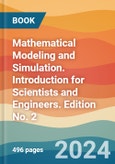Learn to use modeling and simulation methods to attack real-world problems, from physics to engineering, from life sciences to process engineering
Reviews of the first edition (2009):
"Perfectly fits introductory modeling courses [...] and is an enjoyable reading in the first place. Highly recommended [...]"
Zentralblatt MATH, European Mathematical Society, 2009
"This book differs from almost all other available modeling books in that [the authors address] both mechanistic and statistical models as well as 'hybrid' models. [...] The modeling range is enormous."
SIAM Society of Industrial and Applied Mathematics, USA, 2011
This completely revised and substantially extended second edition answers the most important questions in the field of modeling: What is a mathematical model? What types of models do exist? Which model is appropriate for a particular problem? What are simulation, parameter estimation, and validation? What kind of mathematical problems appear and how can these be efficiently solved using professional free of charge open source software?
The book addresses undergraduates and practitioners alike. Although only basic knowledge of calculus and linear algebra is required, the most important mathematical structures are discussed in sufficient detail, ranging from statistical models to partial differential equations and accompanied by examples from biology, ecology, economics, medicine, agricultural, chemical, electrical, mechanical, and process engineering.
About 200 pages of additional material include a unique chapter on virtualization, Crash Courses on the data analysis and programming languages R and Python and on the computer algebra language Maxima, many new methods and examples scattered throughout the book, an update of all software-related procedures, and a comprehensive book software providing templates for typical modeling tasks in thousands of code lines. The book software includes GmLinux, an operating system specifically designed for this book providing preconfigured and ready-to-use installations of OpenFOAM, Salome, FreeCAD/CfdOF workbench, ParaView, R, Maxima/wxMaxima, Python, Rstudio, Quarto/Markdown and other free of charge open source software used in the book.
Table of Contents
Preface xv
1 Principles of Mathematical Modeling 1
1.1 A Complex World Needs Models 1
1.2 Systems, Models, Simulations 3
1.3 Mathematics as a Natural Modeling Language 8
1.4 Definition of Mathematical Models 10
1.5 Examples and Some More Definitions 11
1.6 Even More Definitions 32
1.7 Classification of Mathematical Models 36
1.8 Everything Looks Like a Nail? 41
2 Phenomenological Models 44
2.1 Elementary Statistics 45
2.2 Linear Regression 69
2.3 Multiple Linear Regression 79
2.4 Nonlinear Regression 87
2.5 Smoothing Splines 94
2.6 Neural Networks 97
2.7 Big Data Analysis 109
2.8 Signal Processing 119
2.9 Design of Experiments 124
2.10 Other Phenomenological Modeling Approaches 138
3 Mechanistic Models I: ODEs 142
3.1 Distinguished Role of Differential Equations 142
3.2 Introductory Examples 143
3.3 General Idea of ODE’s 154
3.4 Setting Up ODE Models 158
3.5 Some Theory You Should Know 165
3.6 Solution of ODE’s: Overview 174
3.7 Closed Form Solutions 176
3.8 Numerical Solutions 192
3.9 Fitting ODE’s to Data 208
3.10 More Examples 216
4 Mechanistic Models II: PDEs 237
4.1 Introduction 237
4.2 The Heat Equation 241
4.3 Some Theory You Should Know 247
4.4 Closed-Form Solutions 259
4.5 Numerical Solution of PDEs 262
4.6 The Finite Difference Method 263
4.7 The Finite Element Method 269
4.8 The Finite Volume Method 276
4.9 Software Packages to Solve PDEs 283
4.10 A Sample Session on the Numerical Solution of Thermal Conduction 285
4.11 A Look Beyond the Heat Equation 316
4.12 Computational Fluid Dynamics (CFD) 328
4.13 Numerical Solutions of Example Flow Problems 331
4.14 Other Mechanistic Modeling Approaches 352
5 Virtualization 358
5.1 Introduction 358
5.2 Virtual Plants 359
5.3 Examples of Advanced Applications 371
6 Crashcourses and Book Software 395
6.1 Crashcourse R 395
6.2 Crashcourse Maxima 426
6.3 CrashCrashcourse Python (and all the rest) 433
6.4 Book Software and GmLinux 434
References 435
Index 455








